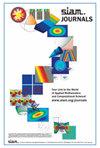Bijective Density-Equalizing Quasiconformal Map for Multiply Connected Open Surfaces
IF 2.3
3区 数学
Q3 COMPUTER SCIENCE, ARTIFICIAL INTELLIGENCE
引用次数: 0
Abstract
SIAM Journal on Imaging Sciences, Volume 17, Issue 1, Page 706-755, March 2024.Abstract.This paper proposes a novel method for computing bijective density-equalizing quasiconformal flattening maps for multiply connected open surfaces. In conventional density-equalizing maps, shape deformations are solely driven by prescribed constraints on the density distribution, defined as the population per unit area, while the bijectivity and local geometric distortions of the mappings are uncontrolled. Also, prior methods have primarily focused on simply connected open surfaces but not surfaces with more complicated topologies. Our proposed method overcomes these issues by formulating the density diffusion process as a quasiconformal flow, which allows us to effectively control the local geometric distortion and guarantee the bijectivity of the mapping by solving an energy minimization problem involving the Beltrami coefficient of the mapping. To achieve an optimal parameterization of multiply connected surfaces, we develop an iterative scheme that optimizes both the shape of the target planar circular domain and the density-equalizing quasiconformal map onto it. In addition, landmark constraints can be incorporated into our proposed method for consistent feature alignment. The method can also be naturally applied to simply connected open surfaces. By changing the prescribed population, a large variety of surface flattening maps with different desired properties can be achieved. The method is tested on both synthetic and real examples, demonstrating its efficacy in various applications in computer graphics and medical imaging.
多重连接开放曲面的双射密度均衡准等差映射
SIAM 影像科学期刊》,第 17 卷第 1 期,第 706-755 页,2024 年 3 月。 摘要.本文提出了一种新方法,用于计算多连通开放曲面的双射密度均衡化类射扁平化映射。在传统的密度均衡贴图中,形状变形仅由密度分布(定义为单位面积上的人口数量)的规定约束驱动,而贴图的双射性和局部几何变形则不受控制。此外,先前的方法主要针对简单连接的开放曲面,而不是拓扑结构更为复杂的曲面。我们提出的方法克服了这些问题,将密度扩散过程表述为准共形流,从而有效地控制了局部几何变形,并通过解决涉及映射的贝尔特拉米系数的能量最小化问题,保证了映射的双射性。为了实现多重连接曲面的最优参数化,我们开发了一种迭代方案,既能优化目标平面圆域的形状,又能优化其上的密度均衡准共形映射。此外,我们提出的方法还可以加入地标约束,以实现一致的特征对齐。该方法也可自然地应用于简单连接的开放表面。通过改变规定的群体,可以实现具有不同理想属性的多种表面平整图。该方法在合成和实际例子中都进行了测试,证明了它在计算机制图和医学成像等各种应用中的有效性。
本文章由计算机程序翻译,如有差异,请以英文原文为准。
求助全文
约1分钟内获得全文
求助全文
来源期刊

SIAM Journal on Imaging Sciences
COMPUTER SCIENCE, ARTIFICIAL INTELLIGENCE-COMPUTER SCIENCE, SOFTWARE ENGINEERING
CiteScore
3.80
自引率
4.80%
发文量
58
审稿时长
>12 weeks
期刊介绍:
SIAM Journal on Imaging Sciences (SIIMS) covers all areas of imaging sciences, broadly interpreted. It includes image formation, image processing, image analysis, image interpretation and understanding, imaging-related machine learning, and inverse problems in imaging; leading to applications to diverse areas in science, medicine, engineering, and other fields. The journal’s scope is meant to be broad enough to include areas now organized under the terms image processing, image analysis, computer graphics, computer vision, visual machine learning, and visualization. Formal approaches, at the level of mathematics and/or computations, as well as state-of-the-art practical results, are expected from manuscripts published in SIIMS. SIIMS is mathematically and computationally based, and offers a unique forum to highlight the commonality of methodology, models, and algorithms among diverse application areas of imaging sciences. SIIMS provides a broad authoritative source for fundamental results in imaging sciences, with a unique combination of mathematics and applications.
SIIMS covers a broad range of areas, including but not limited to image formation, image processing, image analysis, computer graphics, computer vision, visualization, image understanding, pattern analysis, machine intelligence, remote sensing, geoscience, signal processing, medical and biomedical imaging, and seismic imaging. The fundamental mathematical theories addressing imaging problems covered by SIIMS include, but are not limited to, harmonic analysis, partial differential equations, differential geometry, numerical analysis, information theory, learning, optimization, statistics, and probability. Research papers that innovate both in the fundamentals and in the applications are especially welcome. SIIMS focuses on conceptually new ideas, methods, and fundamentals as applied to all aspects of imaging sciences.
 求助内容:
求助内容: 应助结果提醒方式:
应助结果提醒方式:


